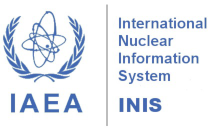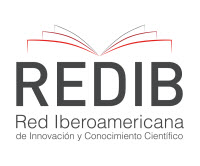The Influence of Au, Gd and I Nanoparticles on Radiation Dose Absorption during High Dose Rate Brachytherapy with 192Ir Source
DOI:
https://doi.org/10.15392/2319-0612.2025.2823Palabras clave:
Nanoparticles, Dose Enhancement, HDR BrachytherapyResumen
The efficacy of high dose rate (HDR) brachytherapy for cervical cancer is often constrained by the high radiation exposure to the healthy tissues that surround the tumor consequently diminishing the therapeutic benefits of the technique. A promising approach to mitigate this challenge is the use of high atomic number (Z) nanoparticles, such as Gold nanoparticles (GNPs), Gadolinium nanoparticles (GdNPs) and Iodine nanoparticles (INPs), which act as radioation dose enhancers. This study evaluates the influence of GNPs, GdNPs and INPs nanoparticles on dose absorption during 192Ir HDR brachytherapy using Geant4 based Monte Carlo (G4MC) simulation. The study deployed nanoparticles of various concentrations ranging from 3 mg/g to 30 mg/g. It was found that the presence of these nanoparticles significantly increases the dose in the tumor with GNPs causing higher dose deposition to the tumor than it is the case for GdNPs and INPs. It was further observed that the Dose Enhancement Factor (DEF) depends on the concentration and type of the nanoparticles. The maximum DEF was obtained at the concentration of 30 mg/g for each type of nanoparticle with the corresponding values being 1.82 for GNPs, 1.42 for GdNPs and 1.38 for INPs. These results indicate that incorporation of GNPs, GdNPs and INPs in HDR brachytherapy can enhance the efficacy of cancer tumor eradication. Hence, the use of GNPs during HDR brachytherapy at the concentration of 30 mg/g is recommended for effective cervical cancer treatment and management.
Descargas
Referencias
[1] LYIMO, E. P.; RUMISHA, S.F.; MREMI, I.R.; KISHAMAWE, C.; CHIDUO, M.G.; MATEMBA, L.E.; BWANA, V.M.; MASAWE, I.S.; MBOERA, L.E.G. Cancer mortality patterns in Tanzania: A retrospective hospital-based study, 2006-2015. JCO Global Oncology, Alexandria, n. 6, p. 224–232, 2020. DOI: https://doi.org/10.1200/JGO.19.00270
[2] BRAY, F.; LAVERSANNE, M.; SUNG, H.; FERLAY, J.; SIEGEL, R.L.; SOERJOMATARAM, I.; JEMAL, A. Global cancer statistics 2022: GLOBOCAN estimates of incidence and mortality worldwide for 36 cancers in 185 countries. CA A Cancer Journal for Clinicians, v. 74, n. 3, p. 229–263, 2024. DOI: https://doi.org/10.3322/caac.21834
[3] SHEN, H.; HUANG, H.; JIANG, Z. Nanoparticle-based radiosensitization strategies for improving radiation therapy. Frontiers in Pharmacology, v. 14, p. 1145551, 2023. DOI: https://doi.org/10.3389/fphar.2023.1145551
[4] STROHMAIER, S.; ZWIERZCHOWSKI, G. Comparison of 60Co and 192Ir sources in HDR brachytherapy. Journal of Contemporary Brachytherapy, v. 4, p. 199–208, 2011. DOI: https://doi.org/10.5114/jcb.2011.26471
[5] FUENTEALBA, M.; SANTIBÁÑEZ, M. Monte Carlo evaluation of the dose sparing and dose enhancement by combination of Gd-infused tumor and 241Am source for an endocavitary brachytherapy geometry. Applied Radiation and Isotopes, v. 163, p. 109194, 2020. DOI: https://doi.org/10.1016/j.apradiso.2020.109194
[6] HULL, R.; MBELE, M.; MAKHAFOLA, T.; HICKS, C.; WANG, S.M. Cervical cancer in low and middle‑income countries (Review). Oncology Letters, v. 20, n. 3, p. 2058–2074, 2020. DOI: https://doi.org/10.3892/ol.2020.11754
[7] PALMER, A.; BRADLEY, D.; NISBET, A. Physics-aspects of dose accuracy in high dose rate (HDR) brachytherapy: source dosimetry, treatment planning, equipment performance and in vivo verification techniques. Journal of Contemporary Brachytherapy, v. 2, p. 81–91, 2012. DOI: https://doi.org/10.5114/jcb.2012.29364
[8] ARIF, M.; NAWAZ, A.F.; ULLAH KHAN, S.; MUEEN, H.; RASHID, F.; HEMED, H.; RAUF, A. Nanotechnology-based radiation therapy to cure cancer and the challenges in its clinical applications. Heliyon, v. 9, n. 6, p. e17252, 2023. DOI: https://doi.org/10.1016/j.heliyon.2023.e17252
[9] GERKEN, L.R.H.; GERDES, M.E.; PRUSCHY, M.; Herrmann, I.K. Prospects of nanoparticle-based radioenhancement for radiotherapy. Materials Horizons, v. 10, n. 10, p. 4059–4082, 2023. DOI: https://doi.org/10.1039/D3MH00265A
[10] KAZMI, F.; VALLIS, K.A.; VELLAYAPPAN, B.A.; BANDLA, A.; YUKUN, D.; CARLISLE, R. Megavoltage radiosensitization of gold nanoparticles on a glioblastoma cancer cell line using a clinical platform. International Journal of Molecular Sciences, v. 21, n. 2, p. 429, 2020. DOI: https://doi.org/10.3390/ijms21020429
[11] HASHEMI, S.; AGHAMIRI, M.R.; KAHANI, M.; JABERI, R. Investigation of gold nanoparticle effects in brachytherapy by an electron emitter ophthalmic plaque. International Journal of Nanomedicine, v. 14, p. 4157–4165, 2019. DOI: https://doi.org/10.2147/IJN.S205814
[12] KUNCIC, Z.; LACOMBE, S. Nanoparticle radio-enhancement: principles, progress and application to cancer treatment. Physics in Medicine and Biology, v. 63, n. 2, p. 02TR01, 2018. DOI: https://doi.org/10.1088/1361-6560/aa99ce
[13] YOGO, K.; MISAWA, M.; SHIMIZU, M.; KITAGAWA, T.; HIRAYAMA, R.; ISHIYAMA, H.; FURUKAWA, T.; YASUDA, H. Effect of gold nanoparticle radiosensitization on plasmid DNA damage induced by High-Dose-Rate brachytherapy. International Journal of Nanomedicine, v. 16, p. 359–370, 2021. DOI: https://doi.org/10.2147/IJN.S292105
[14] BRIVIO, D.; ZYGMANSKI, P.; ARNOLDUSSEN, M.; HANLON, J.; CHELL, E.; SAJO, E.; MAKRIGIORGOS, G.M.; NGWA, W. Kilovoltage radiosurgery with gold nanoparticles for neovascular age-related macular degeneration (AMD): a Monte Carlo evaluation. Physics in Medicine and Biology, v. 60, n. 24, p. 9203–9213, 2015. DOI: https://doi.org/10.1088/0031-9155/60/24/9203
[15] GHORBANI, M.; BAKHSHABADI, M.; GOLSHAN, A.; KNAUP, C. Dose enhancement by various nanoparticles in prostate brachytherapy. Australasian Physical and Engineering Science in Medicine, v. 36, n. 4, p. 431–440, 2013. DOI: https://doi.org/10.1007/s13246-013-0231-z
[16] CHEN, Y.; YANG, J.; FU, S.; WU, J. Gold nanoparticles as radiosensitizers in cancer radiotherapy. International Journal of Nanomedicine, v. 15, p. 9407–9430, 2020. DOI: https://doi.org/10.2147/IJN.S272902
[17] GUAL, M.R.; CARDONA, C.M.A.; GONZÁLEZ, L.Y.C.; GARCÍA, J.R. Use of nanoparticles in brachytherapy – An alternative for enhancing doses in cancer treatment. In: MAGJAREVIC, R.; DÖSSEL, O.; SCHLEGEL, W. World congress on medical physics and biomedical engineering September 7 - 12, 2009, Munich, Germany. Berlin, Heidelberg: Springer Berlin Heidelberg, 2009. p. 544–547. DOI: https://doi.org/10.1007/978-3-642-03474-9_153
[18] WU, C.H.; LIAO, Y.J.; LIU, Y.W.H.; HUNG, S.K.; LEE, M.S.; HSU, S.M. Dose distributions of an 192Ir brachytherapy source in different media. BioMed Research International, v. 2014, p. 1–11, 2014. DOI: https://doi.org/10.1155/2014/946213
[19] ZANGENEH, M.; NEDAEI, H.A.; MOZDARANI, H.; MAHMOUDZADEH, A.; SALIMI, M. Enhanced cytotoxic and genotoxic effects of gadolinium-doped ZnO nanoparticles on irradiated lung cancer cells at megavoltage radiation energies. Materials Science and Engineering: C, v. 103, p. 109739, 2019. DOI: https://doi.org/10.1016/j.msec.2019.109739
Descargas
Publicado
Número
Sección
Licencia
Derechos de autor 2025 Damian Peter, Innocent Lugendo

Esta obra está bajo una licencia internacional Creative Commons Atribución 4.0.
Licencia: los artículos de BJRS tienen una licencia internacional Creative Commons Attribution 4.0, que permite el uso, el intercambio, la adaptación, la distribución y la reproducción en cualquier medio o formato, siempre que se otorgue el crédito correspondiente al autor o autores originales y a la fuente, proporcione un enlace a la licencia Creative Commons e indique si se realizaron cambios. Las imágenes u otros materiales de terceros en el artículo están incluidos en la licencia Creative Commons del artículo, a menos que se indique lo contrario en una línea de crédito al material. Si el material no está incluido en la licencia Creative Commons del artículo y su uso previsto no está permitido por la regulación legal o excede el uso permitido, el autor deberá obtener el permiso directamente del titular de los derechos de autor. Para ver una copia de esta licencia, visite http://creativecommons.org/licenses/by/4.0/






















